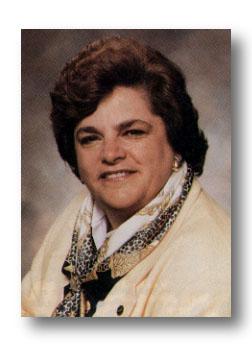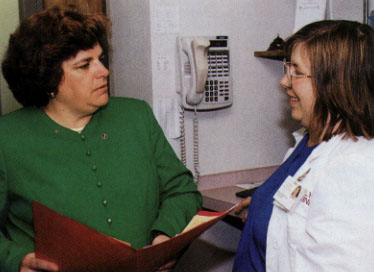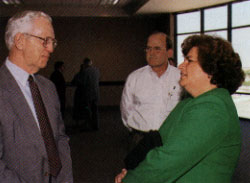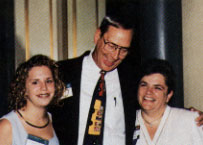
Doctors and patients must make hard choices or face “the dark ages of medicine,” warns family physician Nancy Dickey, MD.
Fam Pract Manag. 1998;5(6):25-36

One year ago the AMA gave itself a 150th birthday present by voting in its first female president-elect, Nancy W. Dickey, MD, a family physician and teacher from the Houston area. This month marks the beginning of her year-long tenure as president. In March we asked our readers whether they had any questions they would like to ask their fellow FP on the eve of her assuming one of medicine's most powerful posts. The response was surprisingly strong. So strong, in fact, we were obliged to select from the wide variety of communications we received those questions that seemed to represent the majority of your concerns. In a recent interview we put your questions to Dr. Dickey. Here are her answers.
FPM: What do you hope to accomplish as AMA president?
Dickey: The role of the AMA president is to represent the AMA. So, to some degree, I'm bound by the priorities set by the House of Delegates. Along with that, however, my own priorities are to talk about recommitment to professionalism. I believe the changes in health care delivery have threatened our knowledge of, and commitment to, professionalism. I think our patients question sometimes just who and what we're committed to. We need to find some ways to visibly and measurably recommit to standards of professionalism.
FPM: What do you mean by professionalism?
Dickey: To me, the doctor-patient relationship is the foundation of the profession. It's what preserves the best of medicine. Both doctors and patients have been lured away from that. Patients have been lured by the appeal of having somebody else pay for their care, doctors by the appeal of having a guaranteed payment for the care we render. Concerns about the cost of care have caused us to turn to others to address cost issues. I think we have to educate patients about the damage that may result if they ignore the doctor-patient relationship, but we also have to remind physicians that if we lose the primacy of the doctor-patient relationship, then we are at great risk of losing professionalism and facing the dark ages of medicine.
FPM: What can be done to refocus physicians' attention on the doctor-patient relationship?
Dickey: Let me give you an example of what we have already accomplished. Doing away with gag clauses was extraordinarily important. It reminded both physicians and patients that the lure of signing a contract might cause them to minimize something that turns out to be extraordinarily important: freedom of communication. We said, in effect, “You cannot have gag clauses. If there are gag clauses, you cannot sign the contract.” I think this action by the AMA began the process of educating patients. It said to them, “Be careful. Just getting your health care paid for may extract too high a price.” I think both physicians in seeking payment, and patients in seeking coverage, are going to have to begin to ask tough questions about what price is being asked of them.
FPM: How does your family medicine orientation affect your priorities?
Dickey: I suspect that 20 years of patient-centered care and family practice, where I believe one of the greatest rewards is the opportunity to interact with and advocate for my patients, comes through loud and clear, whether I'm talking about professionalism, health care reform or some other issue. There's little doubt that it occasionally colors my perspective on a particular issue, but I think it's important for the president of the organization that speaks for physicians across all specialties to be very careful not to come to the platform carrying a substantial bias for or against any particular perspective of medicine, whether that perspective be age, gender or specialty.
FPM: What can be done in the increasingly competitive environment to foster collegiality among physicians from different specialties? Does the AMA have a role to play in bringing together the primary care specialties?
Dickey: I think one of the roles the AMA clearly fulfills is to be a convenor: to bring together not only those people who have disparate views in order to find a common ground, but those who have common interests and need an opportunity to come together to explore and develop those interests, as in primary care. It's something we do frequently, whether it's bringing the primary care specialties together or bringing employed physicians together with management physicians. I think the role of convenor has served the profession extraordinarily well, and it's one the AMA will continue to fill through my tenure.
FPM: How do you feel about physician unions?
Dickey: The AMA is opposed to unionization. We have concerns that the tools used by unions, particularly the ultimate tool of a strike, are not consistent with the ethics of medicine and with the ability to provide care for patients. But we do believe that physicians should have the right to negotiate in groups in order to provide themselves with a strong voice when dealing with managed care organizations over quality-of-care issues, for example, or with hospitals over working conditions. However, there's a difference between the sort of negotiating I've just described and both the tools and mechanisms of unions.
FPM: Then what can physicians do to regain control of the health care system?
Dickey: One of the best things we can do is to continue to advocate strongly for legislation that would allow increased choice. We should seek those changes and regulations that would enable physicians to choose the system that best serves their particular perspectives and enable patients to choose the system that's best for them. The AMA believes in pluralism — meaning that we should have a range of opportunities, from medical savings accounts to traditional insurance to managed care. If we have only one system, the individual physician won't have as much opportunity to exercise the leadership that he or she might wish to. Secondly, we have formed a division of the AMA called the Division for Physician and Patient Advocacy that works with physicians to empower them to negotiate. The division is made up of AMA staff who work with specialty organizations like the AAFP, state organizations and others with similar concerns. We've formed this division to assure physicians a strong voice even as the health care delivery system evolves.
FPM: Why did the AMA work with HCFA in developing documentation guidelines for E/M services?
Dickey: I think it would be an interview in itself to address the process leading up to the guidelines. The nomenclature, the coding system, was developed with the medical profession back in the 1920s. This coding system existed primarily for the use of doctors talking to doctors until the 1980s, when HCFA decided that it needed a single system rather than the multiple systems that were floating around. At that time the AMA decided that it was better to have a system in which we had some input than one that was a black box. So in the 1980s, when HCFA decided to use the AMA coding system, we signed a contract with HCFA. We put together the CPT process, which includes the CPT Editorial Panel and the CPT Advisory Committee, on which some 90 specialties are represented. All these specialties have input into the CPT coding system. So for almost 20 years, the profession has worked with HCFA in modifying the coding system, making changes as technology changed. When the RBRVS process was introduced and Congress mandated that HCFA write some guidelines for how the new E/M codes would be used, the CPT process, of course, became the vehicle to do that.
FPM: What role did the AMA play in the development of the guidelines?
Dickey: Although the CPT Editorial Panel and the CPT Advisory Committee are convened by the AMA, developing the guidelines was actually a profession-wide process that included the 90 specialties represented on the CPT Advisory Committee. The first sort of guidelines that came out were essentially vignettes that described what a level 1 exam, for example, would be like. Doctors said “Wait a minute, we've worked with HCFA before. If we're going to be held responsible for this, we want something more than vignettes.” And so the second set of guidelines came out in 1994. These guidelines were based primarily on a generalist's perspective. So then it was the subspecialists' turn to say “Wait a minute. I take care of this patient's cardiac, pulmonary or renal problems as referred by Dr. Dickey. If I use only these guidelines, I can never bill more than a 99213.” So back to the CPT panel, back for another set of guidelines. And, in fact, in an attempt to meet the comments of the profession as well as the needs of HCFA, what we came out with was an absolutely unworkable set of documentation guidelines. That became clear as we came closer to the Jan. 1, 1998, implementation date and doctors began looking at it and saying, “I don't think I can make this work. They're extremely time-consuming, they're very detailed, and because of the FBI mentality of the enforcement, I'm concerned that unintended error will suddenly become a criminal act.” So the AMA became very involved in seeking an extension of the grace period so that we could do some further work on the guidelines. There has been a tremendous amount of communication with HCFA about the problems with the guidelines. [Editor's note: Shortly after this interview was conducted, HCFA announced an indefinite delay in implementation of the guidelines and the CPT Editorial Panel unveiled proposed changes in the guidelines. See “Changes Proposed for the Documentation Guidelines” for more information.]
On a recent day, Dickey divided her time between Brazos Valley Family Practice Residency Program in Bryan, Texas, where she is director, and a fund-raiser luncheon for a free health clinic, Health for All Inc. She talked with resident Anna Lichorad, MD, of Brazos Valley and with audience members after giving a speech at the fund-raiser.


Dickey; her husband, Franklin; and their daughter Elizabeth at the AMA meeting at which Dickey became president-elect. The Dickeys have two other children, Danielle and Wilson.

FPM: How big a challenge is it to comply with all the recent and forthcoming changes related to Medicare fraud and abuse?
Dickey: It's always a huge challenge. At a recent hearing, somebody indicated that the IRS has something like 13,000 pages of regulations and Medicare has something like 46,000. It's an extraordinarily detailed, very complex process, and the regulations imply more and more that the assumption is that you're guilty until proven innocent. It makes it increasingly difficult both philosophically and in actuality for physicians to comply.
FPM: How is the AMA responding to the problem?
Dickey: We were very involved in the language that assured that fraud and abuse had to have intent, not just occasional error. We were also very aggressive in communicating to Congress the concerns of physicians that errors may become equated with criminality, and that the doctor-patient relationship is being damaged through communications to patients that suggest that they assume their doctor is defrauding them until proven otherwise. We will continue to work diligently to ensure that the guidelines are functional and workable, and that they serve patient needs. Of course, we will also continue to communicate that the profession and the organizations that represent the profession do not endorse, nor will we tolerate, those physicians who are intentionally defrauding the system.
At the same time, however, we believe that the accusation that there is literally billions of dollars of fraud occurring out there needs to be re-examined. We believe that in reality a great deal of this has nothing to do with physicians. In fact, testimony at a congressional hearing I attended recently indicated that this figure was an estimate and not yet proven. Yet Congress appears to have folded that number into its budget figures. So we continue to advocate for appropriate language in legislation or regulations; we continue to attempt to provide tools and education for physicians, so that they know what the existing rules are and what they can do to help us change those rules to make them more functional; and we continue to work with HCFA and other groups to make sure they understand the impact of some of their rules and try to modify them where necessary.
FPM: What is the AMA doing to help family physicians who are not eligible to sit for board certification exams because they did not complete residency training? Will the AMA advocate a “practice experience track”?
Dickey: We've left eligibility issues up to the individual boards. However, we have communicated our concerns to them, as well as our data showing that many people are impacted by this issue. We also have a very strong policy that's been in place for some time indicating that such items as privileging and contracting should be based on a whole series of measures. While board certification may well be one of those measures, training, experience and demonstrated competence should also be part of the equation.
FPM: What should be the role of nurse practitioners and physician assistants? Are you concerned about de-differentiation between family physicians and mid-level practitioners?
Dickey: I truly am concerned about the continued fuzzing of the differences between different kinds of health care providers. We come with extraordinarily different training, background and expertise. Yet there is a constant influx of regulations and legislation, particularly at the state level (although it seems to be increasing at the federal level), to suggest that it doesn't make any difference whom a patient sees. Now, I also believe — and my own practice demonstrates this — that a collaborative effort between us can best capitalize on the skills, training and expertise of a whole team of people. We need to be sure that we're taking care of our patients first and foremost and that we allow that team concept to enhance the care rather than become a battleground. But, at the same time, to attempt to equate the training of a nurse practitioner or a PA with that of a physician who's gone through medical school and specialty training is unfair to patients and unfair to the professionals.
FPM: How can solo physicians survive and flourish in the managed care era? What is the future of solo practice?
Dickey: I really think it's going to be a tougher row to hoe to be a solo practitioner, partly because solo practitioners have less clout when it comes to negotiating contracts and gaining access to patients. At the same time — and this is related to our earlier conversation about the primacy of the doctor-patient relationship — I believe the ability of the solo practitioner to clearly establish priorities, to say to his or her patients, “This is what I value, this is what will come first in our patient care, in this office,” is something that will allow the really dedicated solo practitioner to do well. I recall recently a wonderful talk a San Francisco-based physician gave to his colleagues about the number of patients who told him what a relief it was to find somebody who said, “I'm not here as an agent of your insurance company. I'm here as your agent. Now let's figure out how we can make the process work for the two of us.” Solo practice is not for everybody, but for the person dedicated to those perceptions, I think it can work.
FPM: What role should family physicians play in terms of patients' access to alternative medicine providers?
Dickey: I think we certainly need to be educated about the issues. And it appears that physicians' offices are increasingly serving as an entry or an opportunity for people to access some alternative care, but we also have to be a source of education for our patients and explain to them that alternative care that does not have a scientific base can be problematic. I don't think we can compromise the commitment to science-based medicine.
FPM: What do you anticipate will be the AMA's relationship with osteopathic physicians in the next century?
Dickey: I think the differences between osteopathic and allopathic physicians — both in their training and orientation — are gradually narrowing. We see increasing numbers of programs that are actually seeking accreditation from both osteopathy and medicine, so it's my expectation that we will continue to partner together and probably learn from each other.
FPM: What do you think the health care system of the future will look like? What will become of the gatekeeper model?
Dickey: I've never liked the concept of the gatekeeper. The gatekeeper model implies that I'm a barrier between my patient and good care, rather than a facilitator of good care. I think the ideal system, and one the AMA is committed to working toward, is a pluralist system that allows patients and physicians to choose the delivery system that works best for them. This means that some people will have something like a medical savings account in which they have control over the expenditures, while others will feel more comfortable by continuing to choose prepaid health care. It also means that we will continue to see increasing use of outcomes and processes of care in order to find efficiencies, because as technology continues to improve, we'll have to find ways to deliver ever more sophisticated care while continuing to take care of prevention, health maintenance and patient education. The only way that will ever work is if we return to the concept of doctors and patients as partners. Partnership means we can not only discuss the merits of the available science and technology, but we can also make decisions about the efficient use of resources for each particular patient.
FPM: How difficult was it for you to attain a position of leadership in an organization that hasn't traditionally focused on the interests of primary care physicians or women physicians?
Dickey: That's a fascinating question because everybody's perception differs. The specialists believe this is a primary care organization, while the primary care physicians believe it's a specialty organization! In actuality, there have been a number of both primary care and family physicians who have served as leaders of the organization. We obviously haven't had any women until now who have reached the top echelons of leadership, but we hope that's something that's changing as the number of women in medicine grows. That is gradually happening. It's a long haul to reach the top echelon of leadership in any national organization, but I don't think I've encountered any particular barrier because of either my specialty or my gender.
FPM: How do you balance your personal life with a professional life that includes maintaining a practice and being active in the AMA? Why did you make the choice to continue practicing?
Dickey: I believe if you're in an organizational leadership position you should try to continue the activities that make you a part of the organization you represent. So I've tried to juggle both my practice and my AMA activities, although after the June meeting I will be taking a leave of absence from my teaching position. It's an extraordinary dream to juggle both. I think that since last June I've been on the road about 230 days. I guess all I can tell you is that it's never just an individual who makes the commitment. It's also both a family and a practice that make a commitment. My partners have had to cover me, and my family has had to tolerate my absence. Without their support, understanding and encouragement, it just wouldn't have happened.
FPM: Finally, what can be done to ensure that our profession continues to receive the respect it has traditionally been given?
Dickey: I think that until we have done the things to convince our patients that nothing, including our own individual financial well-being, will come between us and what is best for them, we will not have that respect. As long as patients question that commitment, we will constantly be fighting an uphill battle. So we need to begin to evaluate both our own individual choices and, as a group, our professional choices to be sure we're sending the right messages.